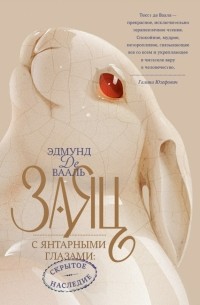
Автор
Лучшие книги Эдмунда де Вааля
- 5 произведений
- 15 изданий на 5 языках
По популярности
-
Заяц с янтарными глазами: скрытое наследие Эдмунд де Вааль
ISBN: 978-5-00195-256-5 Год издания: 2022 Издательство: Манн, Иванов и Фербер Язык: Русский «Заяц с янтарными глазами» — книга-музей; и главные герои здесь — предметы: фигурки нэцке, архивные хранилища, винтовые лестницы. Впрочем, в отличие от классических музеев, в этом нет табличек «руками не трогать», как раз наоборот.
Книга де Вааля — целиком тактильный текст. Автор рассказывает историю своих предков через их коллекции, один за другим перебирая экспонаты — бережно и осторожно, — так мы перебираем бабушкины-дедушкины вещи на чердаке, стирая пыль с орнаментов и шелестя плотной желтой бумагой. Разница только в том, что сам де Вааль роется не на чердаке своего дома, а в чертогах истории — в архивах братьев де Гонкур, Марселя Пруста, Клода Моне и многих других писателей и художников, с которыми дружили его деды и прадеды (Шарль Эфрусси, прадед автора, был прототипом прустовского Свана).
Ярый коллекционер, де Вааль настолько дотошен, что умудрился проследить весь путь своих фигурок-нэцке из Японии во Францию, в Париж XIX века, оттуда в Вену XX века, и дальше — сквозь колючую проволоку 1930-х и 1940-х, когда фигурки были спасены от коричневой чумы усилиями храброй девушки — и дальше-дальше сквозь время, все ближе к читателю. -
The White Road. A Journey Into Obsession Эдмунд де Вааль
ISBN: 9780099575986 Год издания: 2022 Издательство: Vintage Books Язык: Английский "Other things in the world are white but for me porcelain comes first"
A handful of clay from a Chinese hillside carries a promise: that mixed with the right materials, it might survive the fire of the kiln, and fuse into porcelain - translucent, luminous, white.
Acclaimed writer and potter Edmund de Waal sets out on a quest - a journey that begins in the dusty city of Jingdezhen in China and travels on to Venice, Versailles, Dublin, Dresden, the Appalachian Mountains of South Carolina and the hills of Cornwall to tell the history of porcelain. Along the way, he meets the witnesses to its creation; those who were inspired, made rich or heartsick by it, and the many whose livelihoods, minds and bodies were broken by this obsession. It spans a thousand years and reaches into some of the most tragic moments of recent times.
In these intimate and compelling encounters with the people and landscapes who made porcelain, Edmund de Waal enriches his understanding of this rare material, the 'white gold' he has worked with for decades. -
Letters to Camondo Эдмунд де Вааль
ISBN: 0374603480, 9780374603489 Год издания: 2021 Издательство: Straus and Giroux, Farrar Язык: Английский A tragic family history told in a collection of imaginary letters to a famed collector, Moise de Camondo
Letters to Camondo is a collection of imaginary letters from Edmund de Waal to Moise de Camondo, the banker and art collector who created a spectacular house in Paris, now the Musée Nissim de Camondo, and filled it with the greatest private collection of French eighteenth-century art.
The Camondos were a Jewish family from Constantinople, “the Rothschilds of the East,” who made their home in Paris in the 1870s and became philanthropists, art collectors, and fixtures of Belle Époque high society, as well as being targets of antisemitism―much like de Waal's relations, the Ephrussi family, to whom they were connected. Moise de Camondo created a spectacular house and filled it with art for his son, Nissim; after Nissim was killed in the First World War, the house was bequeathed to the French state. Eventually, the Camondos were murdered by the Nazis.
After de Waal, one of the world’s greatest ceramic artists, was invited to make an exhibition in the Camondo house, he began to write letters to Moise de Camondo. These fifty letters are deeply personal reflections on assimilation, melancholy, family, art, the vicissitudes of history, and the value of memory. -
The Pot Book Edmund de Waal
ISBN: 9780714847993 Год издания: 2011 Издательство: Phaidon Press Язык: Английский The history of ceramic art is ingrained in the history of mankind. Clay is one of the very first materials "invented" by man. An essential part of our lives it has been moulded, thrown, glazed, decorated and fired for over 30,000 years in order to preserve and transport food and water. In more recent times clay has been used not just by artisans and potters, but also by artists, designers and architects.
"The Pot Book" is the first publication to document the extraordinary range and variety of ceramic vessels of all periods, in a comprehensive and accessible A to Z format. From a delicate bowl made by an unnamed artisan in China in the third millennium BC, or a jug made in eighteenth-century Dresden, to a plate made by Picasso in 1952, a 'spade form' made by Hans Coper or the vases of Grayson Perry today, it's all in included in this beautifully illustrated collection. Each entry is sequenced in alphabetical order by the name of the artist/potter, the school, or style, creating a grand tour through the very finest examples of the art form. -
20th Century Ceramics Edmund de Waal
ISBN: 978-0500203712 Год издания: 2003 Издательство: Thames & Hudson Ceramics have kept pace with - or even led - new movements in art, from Art Nouveau, Art Deco, the Bauhaus and Futurism, through Abstract Expressionism, Pop and Performance, to Land Art and Installation Art. From orientalism and colour theory to modernism, postmodernism and the profuse diversity of approaches that has characterized the end of the 20th century, this book covers Europe, Scandinavia, Russia, the USA and Japan. The work of exceptional individuals is appraised - including Taxile Doat, Clarice Cliff, Susie Cooper, Bernard Leach, Isamu Noguchi, Hans Coper, Lucie Rie, Joan Miro, Pablo Picasso, Peter Voulkos and Adrian Saxe. The use of ceramics in other disciplines is given close attention: sculptors such as Antony Gormley and Tony Cragg, and even architects, including Frank Gehry, have made ceramics central to their practice.




